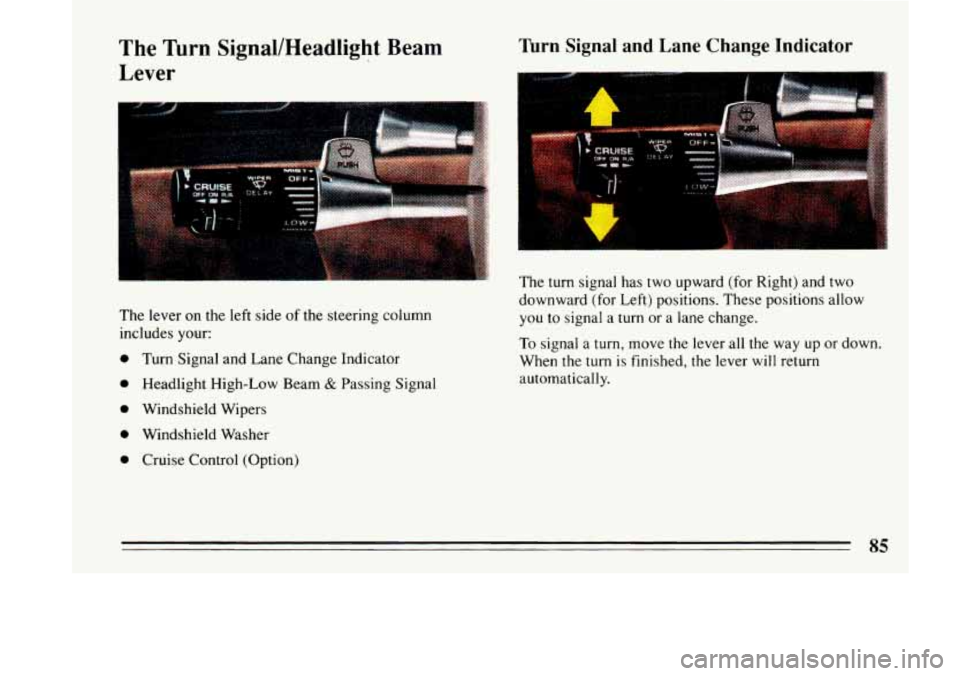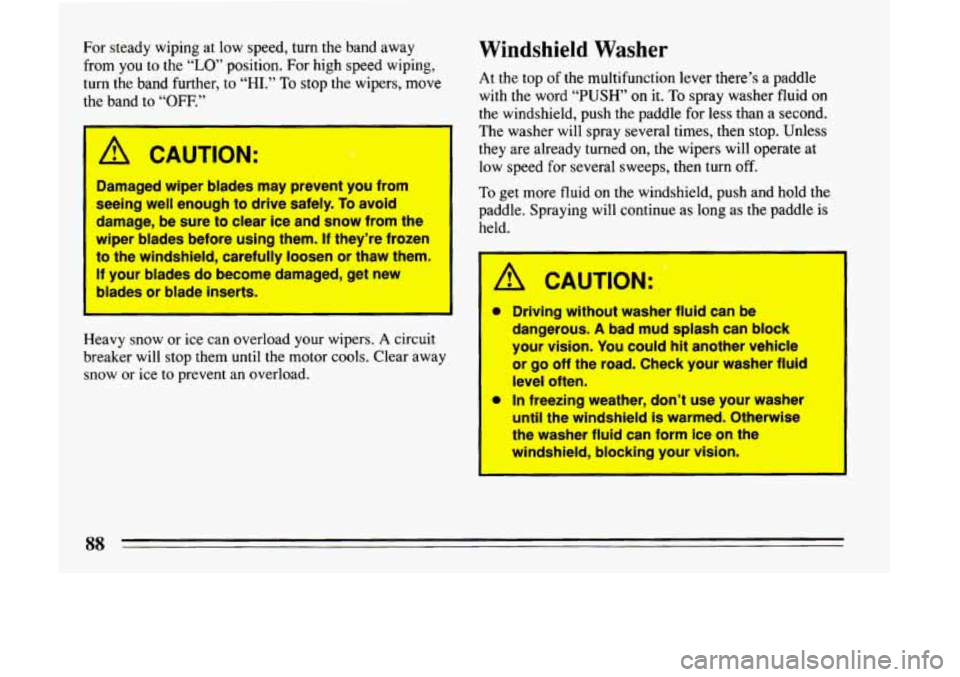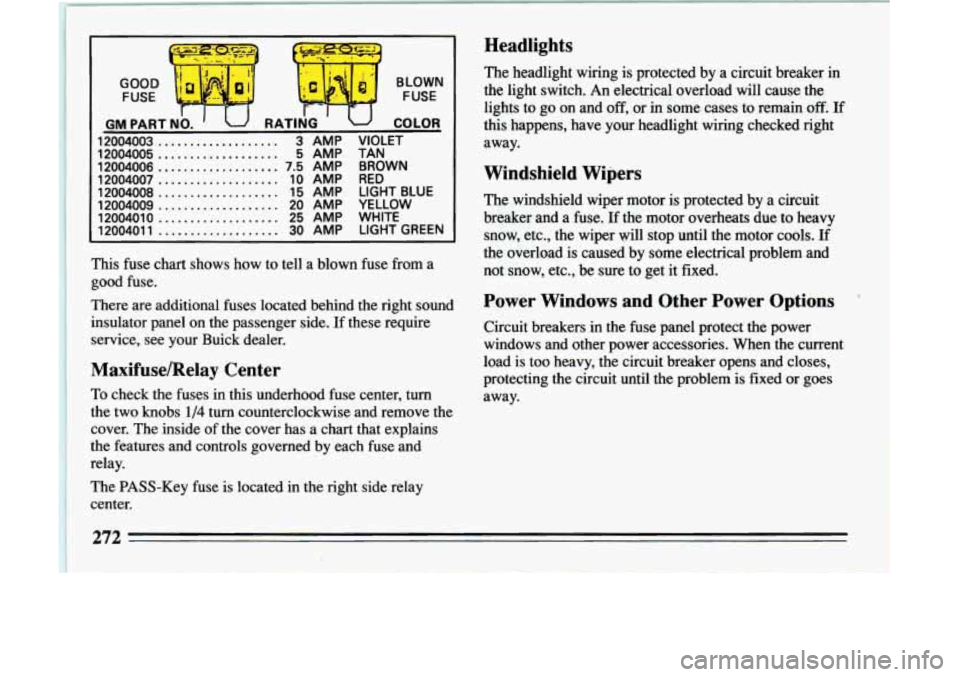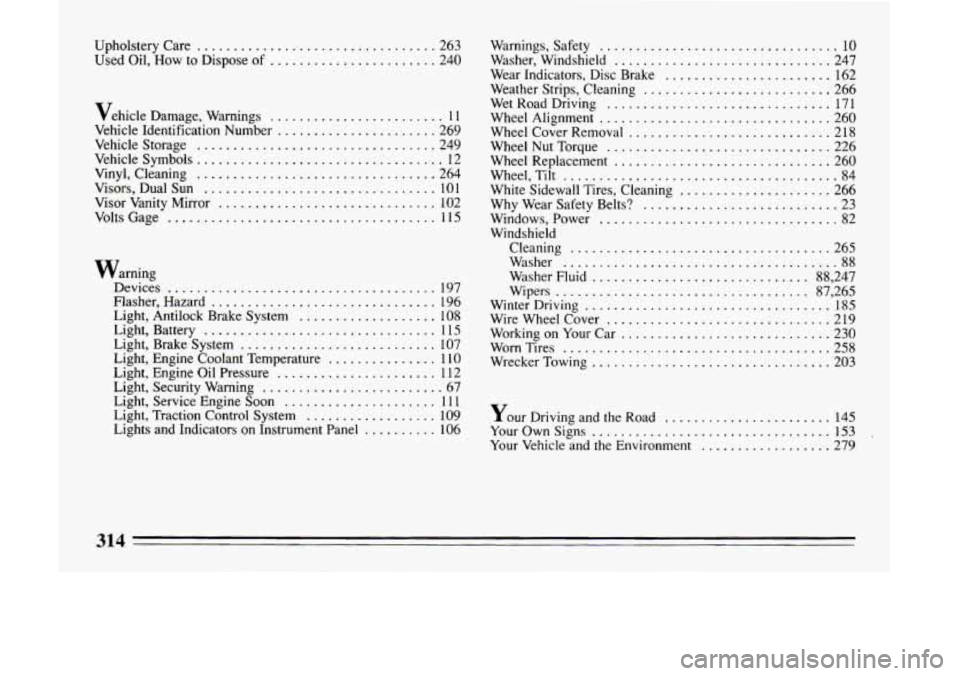1993 BUICK LESABRE windshield wipers
[x] Cancel search: windshield wipersPage 71 of 324

Ignition Key Positions
I
Your square-headed key operates your ignition lock. This
lock gives you five different positions. Before
you
put the key in, your ignition will be in the “Lock”
position. This position locks your ignition, steering
wheel and transaxle. It’s a theft deterrent feature.
The other positions let you perform these functions:
ACC: Accessory lets you use things like the radio and
the windshield wipers when the engine is
off. To get into
“Acc”, push in the key and turn it toward
you. Your
steering wheel will remain locked, just as it was before
you inserted the key.
69
Page 87 of 324

The Turn Signal/Headlight Beam
Lever
The lever on the left side of the steering column
includes your:
0 Turn Signal and Lane Change Indicator
0 Headlight High-Low Beam & Passing Signal
0 Windshield Wipers
0 Windshield Washer
0 Cruise Control (Option)
Turn Signal and Lane Change Indicator
bi
The turn signal has two upward (for Right) and two
downward (for Left) positions. These positions allow
you to signal a turn
or a lane change.
To signal a turn, move the lever all the way up or down.
When
the turn is finished, the lever will return
automatically.
85
Page 89 of 324

some jurisdictions may require that you operate your
lower beam lamps with fog lamps at all times, or that
headlamps be turned on whenever you must
use your
windshield wipers.
In addition, most jurisdictions
prohibit driving solely with parking lamps, especially at
dawn or dusk. It
is recommended that you check with
you own State or Provincial highway authority for
applicable lighting regulations.
Headlight High-Low Beam
’ To change the headlights
from low beam to high or
high to low, pull the turn
signal lever all the way
toward you. Then release it.
When the high beams are
on, this blue light on the
instrument panel also will
be on.
Windshield Wipers
... ,rll
You control the windshield wipers by turning the band
marked “WIPER.”
For a single wiping cycle, turn the band to “MIST.”
Hold it there
until the wipers start, then let go. The
wipers will stop after one cycle. If you want more
cycles, hold the band
on “MIST” longer.
You can set the wiper speed for a long
or short delay
between wipes. This can be very
useful in light rain or
snow. Turn the band
to choose the delay time. The
closer to
“LO,” the shorter the delay.
87
Page 90 of 324

For steady wiping at low speed, turn the band away
from you to the
“LO” position. For high speed wiping,
turn
the band further, to “HI.” To stop the wipers, move
t’ band to “OFF.”
A CAUTION:
Damaged wiper blades may prevent you from
seeing well enough to drive safely.
To avoid
damage, be sure to clear ice and snow from the
wiper blades before using them. If they’re frozen
to the windshield, carefully loosen or thaw them.
If your blades do become damaged, get new
blades or blade inserts.
Heavy snow or ice can overload your wipers. A circuit
breaker will stop them until the motor cools. Clear away snow or ice to prevent an overload.
Windshield Washer
At the top of the multifunction lever there’s a paddle
with the word
“PUSH” on it. To spray washer fluid on
the windshield, push the paddle for less than a second.
The washer will spray several times, then stop. Unless
they are already turned on, the wipers will operate at
low speed for several sweeps, then turn
off.
To get more fluid on the windshield, push and hold the
paddle. Spraying will continue as long as the paddle is
held.
A CAUTION: ’
Driving without washer fluid can be
dangerous. A bad mud splash can block
your vision. You could hit another vehicle
or go off the road. Check your washer fluid
level often.
In freezing weather, don’t use your washer
until the windshield is warmed. Otherwise
the washer fluid can form ice on the
windshield, blocking
your vision.
I
88
Page 176 of 324

Fog can occur with high humidity or heavy frost. It can
be so mild that you can see through it for several
hundred feet (meters). Or it might be
so thick that you
can see only a few feet (meters) ahead. It may come
suddenly to an otherwise clear road. And it can be a
major hazard.
When
you drive into a fog patch, your visibility will be
reduced quickly. The biggest dangers are striking the
vehicle ahead or being struck by the one behind. Try to
“read” the fog density down the road. If the vehicle
ahead starts to become less clear or, at night, if the
taillights are harder to see, the fog is probably
thickening. Slow down to give traffic behind you a
chance to slow down. Everybody then has a better
chance to avoid hitting the vehicle ahead.
A patch of dense fog may extend only for a few feet
(meters) or for miles (kilometers); you can’t really tell
while you’re in
it. You can only treat the situation with
extreme care.
One common fog condition
-- sometimes called mist or
ground fog
-- can happen in weather that seems perfect,
especially at night or in the early morning in valley and
low, marshy areas. You can be suddenly enveloped in
thick, wet haze that may even coat your windshield.
You
can often spot these fog patches or mist layers with your
headlights. But sometimes they can be waiting for
you
as you come over a hill or dip into a shallow valley.
Start your windshield wipers and washer, to help clear
accumulated road dirt. Slow down carefully.
Tips on Driving in Fog
If you get caught in fog, turn your headlights on low
beam, even in daytime. You’ll see
-- and be seen --
better.
Don’t use your high beams. The light will bounce
off the
water droplets that make up fog and reflect back at you.
Use your defogger. In high humidity, even a light
buildup of moisture
on the inside of the glass will cut
down on your already limited visibility. Run your
windshield wipers and washer occasionally. Moisture
can build up on the outside glass, and what seems
to be
fog may actually be moisture on the outside of your
windshield.
Treat dense fog as an emergency. Try to find a place
to
pull off the road. Of course you want to respect
another’s property, but you might need to put something
between
you and moving vehicles -- space, trees,
telephone poles, a private driveway, anything that
removes you from other traffic.
If visibility is near zero and you must stop but are
unsure whether you are away from the road, turn your
Page 274 of 324

-..
I 7
GOOD FUSE
f7-7 6
FUSE
GM PART NO. RATING COLOR
IIU
12004003 ................... 3 AMP VIOLET
12004005
................... 5 AMP TAN
12004006
................... 7.5 AMP BROWN
12004007
................... 10 AMP RED
12004008
................... 15 AMP LIGHT BLUE
12004009
................... 20 AMP YELLOW
12004010
................... 25 AMP WHITE
12004011
................... 30 AMP LIGHT GREEN
This fuse chart shows how to tell a blown fuse from a
good fuse.
There are additional fuses located behind the right sound
insulator panel on the passenger side. If these require service, see your Buick dealer.
Maxifuse/Relay Center
To check the fuses in this underhood fuse center, turn
the two knobs 1/4 turn counterclockwise and remove the
cover. The inside
of the cover has a chart that explains
the features and controls governed by each fuse and
relay.
The PASS-Key fuse is located in the right side relay center.
Headlights
The headlight wiring is protected by a circuit breaker in
the light switch. An electrical overload will cause the
lights to go on and
off, or in some cases to remain off. If
this happens, have your headlight wiring checked right
away.
Windshield Wipers
The windshield wiper motor is protected by a circuit
breaker and
a fuse. If the motor overheats due to heavy
snow, etc., the wiper will stop until the motor cools. If
the overload is caused by
some electrical problem and
not snow, etc., be sure to get it fixed.
Power Windows and Other Power Options
Circuit breakers in the fuse panel protect the power
windows and other power accessories. When the.current
load is too heavy, the circuit breaker opens and closes,
protecting the circuit until the problem is fixed or goes
away.
272
Page 316 of 324

Upholstery Care ................................. 263
Used Oil. How to Dispose
of ....................... 240
Vehicle Damage. Warnings
........................ 1 1
Vehicle Identification Number
...................... 269
Vehicle Storage
................................. 249
Vehicle Symbols
.................................. 12
Vinyl. Cleaning
................................. 264
Visors. Dual
Sun ................................ 10 1
Visor Vanity Mirror .............................. 102
Volts Gage
..................................... 11 5
Warning
Devices
..................................... 197
Flasher. Hazard
............................... 196
Light. Antilock Brake System
................... 108
Light. Battery
................................ 1 15
Light. Brake System
........................... 107
Light. Engine Oil Pressure
...................... 1 12
Light. Security Warning
......................... 67
Light.
Engine Coolant Temperature
............... 11 0
Light. Service Engine Soon ..................... 11 1
Light. Traction Control System
.................. 109
Lights and Indicators
on Instrument Panel .......... 106 Warnings. Safety
................................. 10
Washer. Windshield .............................. 247
Wear Indicators. Disc Brake
....................... 162
Weather Strips. Cleaning
.......................... 266
Wet Road Driving
............................... 171
Wheel Alignment
................................ 260
Wheel Cover Removal
............................ 218
WheelNutTorque
............................... 226
Wheel Replacement
.............................. 260
Wheel. Tilt ...................................... 84
White Sidewall Tires. Cleaning
..................... 266
Why Wear Safety Belts?
............................ 23
Windows. Power
................................. 82
Cleaning .................................... 265
Washer
...................................... 88
Washer Fluid
.............................. 88. 247
Wipers
................................... 87. 265
Winter Driving
.................................. 185
Wire Wheel Cover
............................... 219
Working on Your Car
............................. 230
Worn Tires
..................................... 258
WreckerTowing
................................. 203
Windshield
Your Driving and the Road ....................... 145
Your Own Signs
................................. 153
Your Vehicle and the Environment .................. 279
314